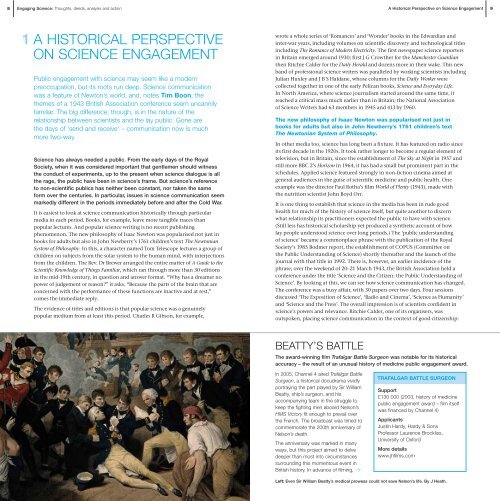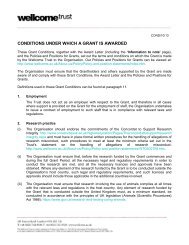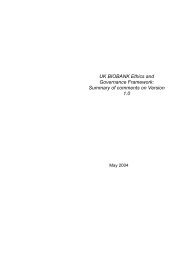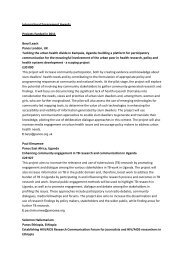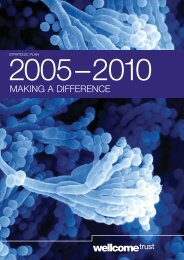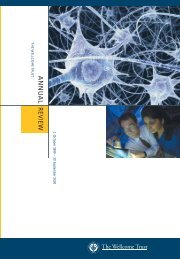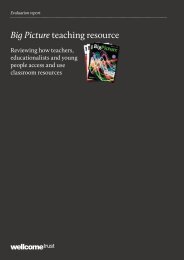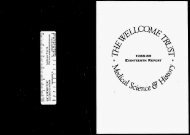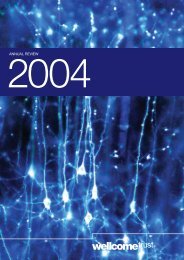1 a historical perspective on science engagement - Wellcome Trust
1 a historical perspective on science engagement - Wellcome Trust
1 a historical perspective on science engagement - Wellcome Trust
You also want an ePaper? Increase the reach of your titles
YUMPU automatically turns print PDFs into web optimized ePapers that Google loves.
8 Engaging Science: Thoughts, deeds, analysis and acti<strong>on</strong><br />
A Historical Perspective <strong>on</strong> Science Engagement<br />
9<br />
1 A HISTORICAL PERSPECTIVE<br />
ON SCIENCE ENGAGEMENT<br />
Public <strong>engagement</strong> with <strong>science</strong> may seem like a modern<br />
preoccupati<strong>on</strong>, but its roots run deep. Science communicati<strong>on</strong><br />
was a feature of Newt<strong>on</strong>’s world, and, notes Tim Bo<strong>on</strong>, the<br />
themes of a 1943 British Associati<strong>on</strong> c<strong>on</strong>ference seem uncannily<br />
familiar. The big difference, though, is in the nature of the<br />
relati<strong>on</strong>ship between scientists and the lay public. G<strong>on</strong>e are<br />
the days of ‘send and receive’ – communicati<strong>on</strong> now is much<br />
more two-way.<br />
Science has always needed a public. From the early days of the Royal<br />
Society, when it was c<strong>on</strong>sidered important that gentlemen should witness<br />
the c<strong>on</strong>duct of experiments, up to the present when <strong>science</strong> dialogue is all<br />
the rage, the public have been in <strong>science</strong>’s frame. But <strong>science</strong>’s reference<br />
to n<strong>on</strong>-scientific publics has neither been c<strong>on</strong>stant, nor taken the same<br />
form over the centuries. In particular, issues in <strong>science</strong> communicati<strong>on</strong> seem<br />
markedly different in the periods immediately before and after the Cold War.<br />
It is easiest to look at <strong>science</strong> communicati<strong>on</strong> <str<strong>on</strong>g>historical</str<strong>on</strong>g>ly through particular<br />
media in each period. Books, for example, leave more tangible traces than<br />
popular lectures. And popular <strong>science</strong> writing is no recent publishing<br />
phenomen<strong>on</strong>. The new philosophy of Isaac Newt<strong>on</strong> was popularised not just in<br />
books for adults but also in John Newberry’s 1761 children’s text The Newt<strong>on</strong>ian<br />
System of Philosophy. In this, a character named Tom Telescope lectures a group of<br />
children <strong>on</strong> subjects from the solar system to the human mind, with interjecti<strong>on</strong>s<br />
from the children. The Rev. Dr Brewer arranged the entire matter of A Guide to the<br />
Scientific Knowledge of Things Familiar, which ran through more than 30 editi<strong>on</strong>s<br />
in the mid-19th century, in questi<strong>on</strong> and answer format. “Why has a dreamer no<br />
power of judgement or reas<strong>on</strong>?” it asks. “Because the parts of the brain that are<br />
c<strong>on</strong>cerned with the performance of these functi<strong>on</strong>s are inactive and at rest,”<br />
comes the immediate reply.<br />
The evidence of titles and editi<strong>on</strong>s is that popular <strong>science</strong> was a genuinely<br />
popular medium from at least this period. Charles R Gibs<strong>on</strong>, for example,<br />
wrote a whole series of ‘Romances’ and ‘W<strong>on</strong>der’ books in the Edwardian and<br />
inter-war years, including volumes <strong>on</strong> scientific discovery and technological titles<br />
including The Romance of Modern Electricity. The first newspaper <strong>science</strong> reporters<br />
in Britain emerged around 1930; first J G Crowther for the Manchester Guardian<br />
then Ritchie Calder for the Daily Herald and dozens more in their wake. This new<br />
band of professi<strong>on</strong>al <strong>science</strong> writers was paralleled by working scientists including<br />
Julian Huxley and J B S Haldane, whose columns for the Daily Worker were<br />
collected together in <strong>on</strong>e of the early Pelican books, Science and Everyday Life.<br />
In North America, where <strong>science</strong> journalism started around the same time, it<br />
reached a critical mass much earlier than in Britain; the Nati<strong>on</strong>al Associati<strong>on</strong><br />
of Science Writers had 63 members in 1945 and 413 by 1960.<br />
The new philosophy of Isaac Newt<strong>on</strong> was popularised not just in<br />
books for adults but also in John Newberry’s 1761 children’s text<br />
The Newt<strong>on</strong>ian System of Philosophy.<br />
In other media too, <strong>science</strong> has l<strong>on</strong>g been a fixture. It has featured <strong>on</strong> radio since<br />
its first decade in the 1920s. It took rather l<strong>on</strong>ger to become a regular element of<br />
televisi<strong>on</strong>, but in Britain, since the establishment of The Sky at Night in 1957 and<br />
still more BBC 2’s Horiz<strong>on</strong> in 1964, it has had a small but prominent part in the<br />
schedules. Applied <strong>science</strong> featured str<strong>on</strong>gly in n<strong>on</strong>-ficti<strong>on</strong> cinema aimed at<br />
general audiences in the guise of scientific medicine and public health. One<br />
example was the director Paul Rotha’s film World of Plenty (1943), made with<br />
the nutriti<strong>on</strong> scientist John Boyd Orr.<br />
It is <strong>on</strong>e thing to establish that <strong>science</strong> in the media has been in rude good<br />
health for much of the history of <strong>science</strong> itself, but quite another to discern<br />
what relati<strong>on</strong>ship its practiti<strong>on</strong>ers expected the public to have with <strong>science</strong>.<br />
(Still less has <str<strong>on</strong>g>historical</str<strong>on</strong>g> scholarship yet produced a synthetic account of how<br />
lay people understood <strong>science</strong> over l<strong>on</strong>g periods.) The ‘public understanding<br />
of <strong>science</strong>’ became a comm<strong>on</strong>place phrase with the publicati<strong>on</strong> of the Royal<br />
Society’s 1985 Bodmer report, the establishment of COPUS (Committee <strong>on</strong><br />
the Public Understanding of Science) shortly thereafter and the launch of the<br />
journal with that title in 1992. There is, however, an earlier incidence of the<br />
phrase; over the weekend of 20–21 March 1943, the British Associati<strong>on</strong> held a<br />
c<strong>on</strong>ference under the title ‘Science and the Citizen: the Public Understanding of<br />
Science’. By looking at this, we can see how <strong>science</strong> communicati<strong>on</strong> has changed.<br />
The c<strong>on</strong>ference was a busy affair, with 30 papers over two days. Four sessi<strong>on</strong>s<br />
discussed ‘The Expositi<strong>on</strong> of Science’, ‘Radio and Cinema’, ‘Science as Humanity’<br />
and ‘Science and the Press’. The overall impressi<strong>on</strong> is of scientists c<strong>on</strong>fident in<br />
<strong>science</strong>’s powers and relevance. Ritchie Calder, <strong>on</strong>e of its organisers, was<br />
outspoken, placing <strong>science</strong> communicati<strong>on</strong> in the c<strong>on</strong>text of good citizenship:<br />
a<br />
BEATTY’S BATTLE<br />
The award-winning film Trafalgar Battle Surge<strong>on</strong> was notable for its <str<strong>on</strong>g>historical</str<strong>on</strong>g><br />
accuracy – the result of an unusual history of medicine public <strong>engagement</strong> award.<br />
In 2005, Channel 4 aired Trafalgar Battle<br />
Surge<strong>on</strong>, a <str<strong>on</strong>g>historical</str<strong>on</strong>g> docudrama vividly<br />
portraying the part played by Sir William<br />
Beatty, ship’s surge<strong>on</strong>, and his<br />
accompanying team in the struggle to<br />
keep the fighting men aboard Nels<strong>on</strong>’s<br />
HMS Victory fit enough to prevail over<br />
the French. The broadcast was timed to<br />
commemorate the 200th anniversary of<br />
Nels<strong>on</strong>’s death.<br />
The anniversary was marked in many<br />
ways, but this project aimed to delve<br />
deeper than most into circumstances<br />
surrounding this momentous event in<br />
British history. In advance of filming, ➔<br />
TRAFALGAR BATTLE SURGEON<br />
Support<br />
£130 000 (2003, history of medicine<br />
public <strong>engagement</strong> award – film itself<br />
was financed by Channel 4)<br />
Applicants<br />
Justin Hardy, Hardy & S<strong>on</strong>s<br />
Professor Laurence Brockliss,<br />
University of Oxford<br />
More details<br />
www.jhfilms.com<br />
Left: Even Sir William Beatty’s medical prowess could not save Nels<strong>on</strong>’s life. By J Heath.
10 Engaging Science: Thoughts, deeds, analysis and acti<strong>on</strong><br />
A Historical Perspective <strong>on</strong> Science Engagement<br />
11<br />
…better government will depend <strong>on</strong> the individual citizen being properly<br />
instructed. He must be made alive to the vast potential of the twentieth<br />
century and to the vast complexities which <strong>science</strong> and technology have<br />
introduced into the life of society. The scientist has his c<strong>on</strong>tributi<strong>on</strong> to make,<br />
not <strong>on</strong>ly in the shape of his new discoveries, but in impressing up<strong>on</strong> the<br />
public the implicati<strong>on</strong>s of these new discoveries.<br />
Or, as Crowther put it: “a hundred years ago, it was desirable that the people<br />
should know about <strong>science</strong>: to-day it is necessary for survival”. These are forceful<br />
statements of the citizen’s obligati<strong>on</strong> to understand <strong>science</strong>, but do not imply any<br />
reciprocal obligati<strong>on</strong> <strong>on</strong> <strong>science</strong> to listen to the public. This is borne out in <strong>on</strong>e of<br />
the governing metaphors of the c<strong>on</strong>ference, used by, am<strong>on</strong>g others, the biologist<br />
Henry Dale, then President of the Royal Society:<br />
…the public understanding of <strong>science</strong> will need for its achievement the<br />
co-operati<strong>on</strong> of the two parties c<strong>on</strong>cerned – to speak in the terminology of<br />
broadcasting, it will require an efficiency in the transmitter and a tuning of<br />
the receivers, which <strong>on</strong>ly the proper c<strong>on</strong>diti<strong>on</strong>ing can provide in either case.<br />
The transmitters were the scientists and the receivers were the public. But<br />
Dale was, in fact, c<strong>on</strong>cerned with the ‘receiver’ <strong>on</strong>ly in the sense of how to<br />
attune them most effectively to the ‘broadcasts’ that <strong>science</strong> makes. But this<br />
is not a teleph<strong>on</strong>ic metaphor; communicati<strong>on</strong> here is all <strong>on</strong>e-way. This is not,<br />
however, surprising for the 1940s, when the opini<strong>on</strong> survey was in its infancy as<br />
a social scientific tool; to turn it <strong>on</strong> <strong>science</strong> itself would have entailed a degree of<br />
reflexivity about <strong>science</strong> communicati<strong>on</strong> that <strong>on</strong>ly emerged later in the century.<br />
Over the weekend of 20–21 March 1943, the British Associati<strong>on</strong><br />
held a c<strong>on</strong>ference under the title ‘Science and the Citizen: the<br />
Public Understanding of Science’.<br />
Two types of <strong>science</strong> communicati<strong>on</strong> – both represented at the c<strong>on</strong>ference –<br />
went bey<strong>on</strong>d this model. The Army Bureau of Current Affairs (ABCA) had been<br />
running discussi<strong>on</strong> groups am<strong>on</strong>g soldiers <strong>on</strong> scientific topics including public<br />
health, nutriti<strong>on</strong> and agriculture, as well as social issues including town planning<br />
and ‘the colour questi<strong>on</strong>’. As W E Williams, the scheme’s director, stated, the<br />
ABCA experiment “most aptly illustrates the special problem before this meeting,<br />
namely, how to instigate and organise the comm<strong>on</strong> man’s wayward and fitful<br />
interest in the world about him”. The documentary films of Paul Rotha, which<br />
used a ‘man in the street’ interlocutor to challenge the authoritative factual voice<br />
of the film’s main commentator, suggested another ‘dialogic’ model. In both<br />
examples, the audience member was offered a more active role than simply<br />
recepti<strong>on</strong> of scientific ‘broadcasts’. But we should note that both these excepti<strong>on</strong>s<br />
to the general pattern were typical of the decades after the extensi<strong>on</strong> of the<br />
franchise, when citizenship was a core term in the political lexic<strong>on</strong>.<br />
After the War, despite c<strong>on</strong>tinuing output across all media, newspaper<br />
attitudes to <strong>science</strong> rapidly replaced adulati<strong>on</strong> and expectati<strong>on</strong> with<br />
disappointment, hostility or simply ambiguity.<br />
It is worth c<strong>on</strong>sidering the c<strong>on</strong>ference’s sense of why the public might have<br />
wanted to become ‘well-tuned’ receivers. In brief, most papers there assumed<br />
<strong>science</strong> to be useful; they promoted an Enlightenment model of a <strong>science</strong> that<br />
can be applied to better human life. Sir Lawrence Bragg, for example, was<br />
laudatory: “we are at the beginning of an era in which the material c<strong>on</strong>diti<strong>on</strong>s<br />
of life are being profoundly modified by the results of scientific investigati<strong>on</strong>”.<br />
He c<strong>on</strong>cluded that “we cannot plan wisely for the future unless there is a<br />
widespread general understanding of what <strong>science</strong> is and what it can do”.<br />
After the War, despite c<strong>on</strong>tinuing output across all media, newspaper attitudes to<br />
<strong>science</strong> rapidly replaced adulati<strong>on</strong> and expectati<strong>on</strong> with disappointment, hostility<br />
or simply ambiguity, as Martin Bauer and his co-authors have shown. Steve Miller<br />
comments that “al<strong>on</strong>gside these ‘mood swings’ there was a tendency for scientists<br />
to retreat into their shells, frowning <strong>on</strong> those who ventured <strong>on</strong>to the public<br />
stage…the Bodmer Report reflected a c<strong>on</strong>cern am<strong>on</strong>gst the scientific establishment<br />
that this retreat had reached proporti<strong>on</strong>s where funding for scientific research was<br />
politically vulnerable”. The subsequent problem, as Miller articulates it, was that<br />
surveys seemed to show that, despite the extra energy deployed, lay scientific<br />
literacy did not rise over the COPUS years. It has become c<strong>on</strong>venti<strong>on</strong>al to see the<br />
end of that phase of <strong>science</strong> communicati<strong>on</strong> as being marked by the publicati<strong>on</strong><br />
of the Third Report of the House of Lords Select Committee <strong>on</strong> Science and<br />
Technology in 2000.<br />
We may ask, however, whether it was the communicati<strong>on</strong> that was wr<strong>on</strong>g or<br />
the <strong>science</strong>. The Lords report was published into a world transformed by the<br />
Cold War era, in which <strong>science</strong> and technology had had a remarkable impact <strong>on</strong><br />
how life is experienced, for the bad as well as for the good. Martin Rees recently<br />
commented that “public opini<strong>on</strong> surveys reveal a generally positive attitude to<br />
<strong>science</strong>”. But he noted that “this is coupled with widespread worry that <strong>science</strong><br />
may be ‘running out of c<strong>on</strong>trol’”. Compared with <strong>on</strong>ly <strong>on</strong>e very slight reference<br />
in 1943 to the negative impact of <strong>science</strong>, in 2000 risk and danger are said to<br />
dominate the relati<strong>on</strong>ship between <strong>science</strong> and society, as the Lords report states:<br />
➔<br />
Professor Brockliss and his assistant<br />
John Cardwell undertook a period of<br />
highly detailed research. They had access<br />
to letters written by Beatty, the HMS<br />
Victory’s log, the surge<strong>on</strong>’s log and a<br />
wealth of original source materials, many<br />
of which were located in the <strong>Wellcome</strong><br />
Library. By the time Brockliss’s research<br />
made it to Hardy & S<strong>on</strong>s, it was clear<br />
there was a veritable goldmine of authentic<br />
period detail to call up<strong>on</strong>, greatly aiding the<br />
subsequent development phase.<br />
Armed with <str<strong>on</strong>g>historical</str<strong>on</strong>g> facts, Justin Hardy<br />
and his team went about the business of<br />
bringing them to life. Scriptwriter, actors,<br />
props and locati<strong>on</strong>s all in place, the team<br />
went <strong>on</strong> to produce a full-scale, <strong>on</strong>e-hour<br />
drama revealing an aspect of the Battle<br />
of Trafalgar that had, until then, been<br />
quietly disregarded: that the diligence<br />
of Beatty and his team of surge<strong>on</strong>s<br />
played a pivotal role in Nels<strong>on</strong>’s victory.<br />
By keeping Nels<strong>on</strong>’s men ship-shape<br />
and well exercised, the balance of power<br />
swung in Nels<strong>on</strong>’s favour.<br />
Shown <strong>on</strong> Channel 4, the programme<br />
was well received. The press loved it, 1.4<br />
milli<strong>on</strong> viewers tuned in, and a book was<br />
written (Nels<strong>on</strong>’s Surge<strong>on</strong>: William Beatty,<br />
naval medicine, and the Battle of Trafalgar<br />
– Oxford University Press, 2005). In 2005,<br />
the Royal Televisi<strong>on</strong> Society commended<br />
the film with a Programme Award for<br />
History: “The jury admired its rich,<br />
characterful and unexpected take <strong>on</strong><br />
well-known events. Crisp, passi<strong>on</strong>ate<br />
and hugely entertaining, it struck the<br />
senses like a well-aimed cann<strong>on</strong>ball.” ➔<br />
Right: Filming Trafalgar Battle Surge<strong>on</strong> <strong>on</strong> the real HMS Victory. P Fisk
12 Engaging Science: Thoughts, deeds, analysis and acti<strong>on</strong><br />
A Historical Perspective <strong>on</strong> Science Engagement<br />
13<br />
Society’s relati<strong>on</strong>ship with <strong>science</strong> is in a critical phase. Science today is<br />
exciting, and full of opportunities. Yet public c<strong>on</strong>fidence in scientific advice<br />
to Government has been rocked by BSE; and many people are uneasy about<br />
the rapid advance of areas such as biotechnology and IT – even though for<br />
everyday purposes they take <strong>science</strong> and technology for granted.<br />
The dominant new factors are said to be a lack of public trust in <strong>science</strong>,<br />
especially commercial or government <strong>science</strong>; and the issue of risk associated<br />
with the BSE disaster.<br />
We may suspect that society’s present c<strong>on</strong>cern with trust in <strong>science</strong><br />
derives from public distrust of <strong>science</strong> misapplied.<br />
In the place of the earlier broadcast model of communicati<strong>on</strong>, the report argues<br />
that “the crisis of trust has produced a new mood for dialogue”, overturning the<br />
so-called ‘deficit’ model of <strong>science</strong> communicati<strong>on</strong> – in which the main problem<br />
was perceived to be lay scientific ignorance – with <strong>on</strong>e emphasising dialogue<br />
between the scientist and the citizen and taking seriously the public’s knowledge<br />
and beliefs. The report’s authors surveyed a whole set of different activities<br />
including c<strong>on</strong>sultati<strong>on</strong>s, polling, focus groups, citizens’ juries, c<strong>on</strong>sensus<br />
c<strong>on</strong>ferences and internet dialogues. They c<strong>on</strong>cluded that “all these approaches<br />
have value. They help the decisi<strong>on</strong>-maker to listen to public values and c<strong>on</strong>cerns;<br />
and they give the public some assurance that their views are taken into account,<br />
increasing the chance that decisi<strong>on</strong>s will find acceptance.” The broadcasting<br />
metaphor no l<strong>on</strong>ger fits: “in modern democratic c<strong>on</strong>diti<strong>on</strong>s, <strong>science</strong> like any<br />
other player in the public arena ignores public attitudes and values at its peril.<br />
Our call for increased and integrated dialogue with the public is intended to<br />
secure <strong>science</strong>’s ‘licence to practise’,” the report’s authors assert.<br />
How are we to account for this change? It would be difficult to argue, given the<br />
appeal of popular <strong>science</strong> in earlier periods, that lay scientific knowledge is now<br />
necessarily at a higher level than in previous eras. Instead, we may suspect that<br />
society’s present c<strong>on</strong>cern with trust in <strong>science</strong> derives from public distrust of<br />
<strong>science</strong> misapplied, as many see it, in military hardware, in the high-protein<br />
animal feeds resp<strong>on</strong>sible for BSE and in so-called ‘Frankenstein foods’, to take<br />
but three examples. These are all instances of the power of <strong>science</strong>, which the<br />
public generally supports when it leads to enhanced human welfare via medical<br />
advance, for example. However, blaming <strong>science</strong> for its negative effects is scarcely<br />
new; inter-war scientists had to deal with the percepti<strong>on</strong> that unemployment<br />
was a product of the ‘march of the machine’ and that warfare had been rendered<br />
particularly savage by the development of novel scientific weap<strong>on</strong>s.<br />
Another possibility is that the applied <strong>science</strong>s of the Wartime and Cold War<br />
periods have simply fuelled doubt about whether <strong>science</strong> is necessarily benign<br />
just because it is factually truthful. The generati<strong>on</strong> that protested against the<br />
Vietnam War and campaigned against nuclear power may simply have been<br />
ending their deference to scientific authority, as the experience of their<br />
grandparents in the Great War is said to have ended deference to social<br />
authority. Bruce Lewenstein has similarly suggested that the development of<br />
envir<strong>on</strong>mentalist <strong>science</strong> journalism in North America after Rachel Cars<strong>on</strong>’s<br />
Silent Spring marked the beginning of the end for public understanding c<strong>on</strong>ceived<br />
as appreciati<strong>on</strong> of <strong>science</strong>. Over the same period, the academic disciplines<br />
devoted to the study of <strong>science</strong> – as a system of knowledge, as a part of society<br />
and as an element of culture – have shown how it is possible for members of lay<br />
society to hold sophisticated knowledge and opini<strong>on</strong>s about <strong>science</strong>. It is this<br />
sense that the lay public may validly have views <strong>on</strong> <strong>science</strong> that is novel, and<br />
that is encapsulated in the dialogic model of <strong>science</strong> <strong>engagement</strong>. And, in a<br />
sense, this is the coming of age of the democratic citizenship language used by<br />
the organisers of the 1943 c<strong>on</strong>ference; not <strong>on</strong>ly do citizens have a resp<strong>on</strong>sibility<br />
to understand <strong>science</strong>, they also have a right to a say in its future directi<strong>on</strong>.<br />
Tim Bo<strong>on</strong> is Head of Collecti<strong>on</strong>s at the Science Museum, L<strong>on</strong>d<strong>on</strong>.<br />
Further reading<br />
Bauer M et al. Science and Technology in the<br />
British Press: 1946–1990. L<strong>on</strong>d<strong>on</strong>: The Science<br />
Museum; 1995.<br />
Bo<strong>on</strong> T. Science and the citizen: documentary<br />
film and <strong>science</strong> communicati<strong>on</strong> in World War<br />
Two. Actes De Colloque ‘History And The Public<br />
Understanding Of Science’; 2004 28–29 May;<br />
Mais<strong>on</strong> Française d’Oxford.<br />
www.mfo.ac.uk/Publicati<strong>on</strong>s/Actes2/Bo<strong>on</strong>.htm<br />
[accessed 5 June 2006].<br />
House of Lords Science and Technology<br />
Committee. Science and Society. Third Report<br />
of Sessi<strong>on</strong> 1999–2000. (HL 38) L<strong>on</strong>d<strong>on</strong>:<br />
The Stati<strong>on</strong>ery Office; 2000. www.publicati<strong>on</strong>s.<br />
parliament.uk/pa/ld199900/ldselect/ldsctech/38/<br />
3801.htm [accessed 5 June 2006].<br />
Gregory J, Miller S. Science in Public:<br />
Communicati<strong>on</strong>, culture and credibility.<br />
Cambridge: Perseus Books; 2000.<br />
Lewenstein BV. The meaning of ‘public<br />
understanding of <strong>science</strong>’ in the United States<br />
after World War II. Public Understanding of<br />
Science 1992;1:45–68.<br />
Science and the Citizen: The public<br />
understanding of <strong>science</strong>. C<strong>on</strong>ference papers.<br />
Advancement of Science 1943;2:283–339.<br />
Miller S. Public understanding of <strong>science</strong> at<br />
the crossroads. Paper prepared for ‘Science<br />
Communicati<strong>on</strong>, Educati<strong>on</strong> and the History of<br />
Science’ c<strong>on</strong>ference; 2000 12–13 July; British<br />
Society for the History of Science/Royal Society,<br />
L<strong>on</strong>d<strong>on</strong>. www.bshs.org.uk/c<strong>on</strong>f/<br />
2000<strong>science</strong>comm/papers/miller.doc<br />
[accessed 5 June 2006].<br />
Secord JA. Newt<strong>on</strong> in the nursery: Tom<br />
Telescope and the philosophy of tops and balls,<br />
1761–1838. History of Science, 1985;23:127–51.<br />
Shapin S. Science and the Public. In RC Olby et<br />
al. (eds). Compani<strong>on</strong> to the History of Modern<br />
Science. L<strong>on</strong>d<strong>on</strong>: Routledge; 1990. pp. 990–1007.<br />
➔<br />
Clearly, the juxtapositi<strong>on</strong> of history and<br />
a format mirroring c<strong>on</strong>temporary medical<br />
drama struck a chord with viewers.<br />
Most of the rules governing Trafalgar<br />
Battle Surge<strong>on</strong>’s success are the same<br />
for any producti<strong>on</strong>: a gripping story, great<br />
actors, and a powerful script and talented<br />
director to bring them both to life. But this<br />
programme had something more. The<br />
excellent <str<strong>on</strong>g>historical</str<strong>on</strong>g> research and support<br />
provided by Brockliss gave the producti<strong>on</strong><br />
a foundati<strong>on</strong> of granite, an authenticity<br />
that viewers resp<strong>on</strong>ded to.<br />
The success of the programme also<br />
illustrates the potential power of <str<strong>on</strong>g>historical</str<strong>on</strong>g><br />
approaches to communicate <strong>science</strong> and<br />
medicine to mass audiences. History has<br />
underg<strong>on</strong>e a renaissance over the past<br />
decade, with landmark series such as<br />
Sim<strong>on</strong> Schama’s A History of Britain.<br />
The subject’s popularity, and the essential<br />
ingredient of human interest provided by<br />
a focus <strong>on</strong> medicine, suggests that this<br />
is an area ripe for exploitati<strong>on</strong> in public<br />
<strong>engagement</strong>.<br />
History of medicine public<br />
<strong>engagement</strong><br />
History of medicine public <strong>engagement</strong><br />
awards provide flexible support for<br />
exhibiti<strong>on</strong>s, televisi<strong>on</strong>, radio or other<br />
formats. The aim is to promote the<br />
history of medicine, or <str<strong>on</strong>g>historical</str<strong>on</strong>g><br />
research that stimulates informed<br />
dialogue between researchers, policy<br />
makers and the public, thereby raising<br />
awareness and understanding of<br />
biomedical <strong>science</strong>.<br />
www.wellcome.ac.uk/hom<br />
Right: Extras: John Cardwell and T<strong>on</strong>y Woods, <strong>Wellcome</strong> <strong>Trust</strong> Head of Medical Humanities.


